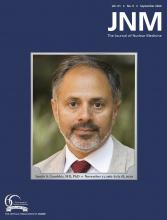In the January 2020 issue of The Journal of Nuclear Medicine, Koerber et al. present a single-institution retrospective analysis of the incidence of nodal involvement in 280 men with newly diagnosed intermediate- and (mostly) high-risk prostate cancer who underwent prostate-specific membrane antigen (PSMA) PET/CT as a part of primary staging. These diagnoses were pathologically validated by subsequent lymphadenectomy, and the investigators compared the observed incidence of lymph node involvement (LNI) with the incidence predicted by the Roach equation (1) by comparing the sensitivity and specificity. The bottom line was that the results appeared to be virtually identical. However, as usual, things are not quite that simple.
The Roach equation, first derived in the early 1990s, uses a simple equation derived from the Partin nomogram to estimate the risk of LNI in prostate cancer, as follows: LNI risk (%) = 2/3 × PSA [(Gleason score − 6) × 10] (2,3). This was validated in a cross-institutional study of nearly 300 patients between 1987 and 1991, and subsequently this equation has been used in several major randomized clinical trials including Radiation Therapy Oncology Group 94-13 (4) and 09-24 to evaluate the role of elective pelvic nodal irradiation in the definitive management of patients with prostate cancer. This evaluation is important because some studies suggest that prophylactic whole-pelvis radiotherapy may decrease treatment failure rates and improve biochemical-relapse–free survival (4,5), though not necessarily disease-free or overall survival (6). However, whether there is a survival benefit added by elective pelvic nodal irradiation awaits the now fully accrued phase III Radiation Therapy Oncology Group 09-24 trial, which enrolled over 2,500 patients with the goal of providing a definitive answer as to the degree of clinical benefit and toxicity of elective whole-pelvis radiotherapy in men with intermediate-risk and high-risk prostate cancer.
However, the accuracy and clinical value of the Roach equation has been called into question. Some studies, including several studies using institutional data and data from large cohorts such as the Surveillance, Epidemiology, and End Results database, have reported that the Roach equation overestimates the risk of LNI (based on nodal findings at the time of prostatectomy) (7,8). This discrepancy is most likely due to underestimation of the rates of LNI in the setting of inadequate pelvic lymph node dissection. More recent studies in which all patients underwent extended pelvic lymph node dissection appeared to confirm the accuracy of the Roach equation (9). PSMA PET and fluciclovine 18F PET studies have demonstrated the role of molecular imaging in physician decision making among patients with biochemical recurrence as well as in the upfront setting among patients with intermediate- and high-risk prostate cancer at the time of initial diagnosis (10–14).
Indeed, Koerber et al. showed that the Roach equation is a good predictor of the risk of LNI, with an average area under the curve of 0.781 (1). This is on a par with that historically reported by Abdollah et al., which showed an area under the curve of 0.803 between the Roach equation and findings based on extended pelvic lymph node dissection (9). Both with PSMA PET and with the Roach equation, roughly 30% of patients had ILN at the time of staging, as might be expected for this cohort, of which 84% had high-risk disease. The authors suggest that on the basis of these findings, the Roach equation is still of value in the current clinical era but tends to lean toward overestimation.
Several limitations are important to consider in interpreting these findings, however. Perhaps most importantly, PSMA PET/CT, whereas highly specific (with most studies reporting rates > 95%), has relatively limited sensitivity, with average sensitivity between 50% and 80% in most studies. The poor sensitivity is due to limits of detection and resolution using PET and CT imaging. For example, in the study by van Leeuwen et al., there was 0% sensitivity for lymph nodes under 2 mm (14). It goes beyond saying that molecular imaging currently, and for the foreseeable future, will not be able to assess the risk of microscopic nodal metastases.
One might ask then what is the role for the Roach equation in the modern molecular imaging era and what is the role of imaging? We believe they are likely to be complementary. The Roach equation would appear to potentially be useful in selecting which patients should be offered such imaging, whereas the imaging can identify the sites of relatively bulky nodal disease, allowing these areas to be selectively targeted. Thus, at the University of California San Francisco, for example, PET-positive areas are given a higher dose (e.g., 60 Gy+ in 25 fractions) than PET-negative nodal drainage areas (e.g., 45–50 Gy).
Overall, we applaud the efforts made by Koerber et al. to examine how molecular imaging may affect the utility of conventional old-fashioned clinical tools such as the Roach equation. Certainly, as molecular imaging and potentially genetic or molecular profiling continue to develop and make their way into the clinic, we must reassess how and which tools should be used in the diagnosis and management of prostate cancer patients. It is worth remembering that such studies as PSMA PET are costly and that the use of such tools as the Roach equation to assess the pretest probability of LNI may be helpful in determining which patients would likely benefit from molecular imaging.
DISCLOSURE
Yun Rose Li is supported by the NIH NCI F32 individual postdoctoral training fellowship. No other potential conflict of interest relevant to this article was reported.
Footnotes
Published online May 22, 2020.
- © 2020 by the Society of Nuclear Medicine and Molecular Imaging.
REFERENCES
- Received for publication April 21, 2020.
- Accepted for publication April 22, 2020.







